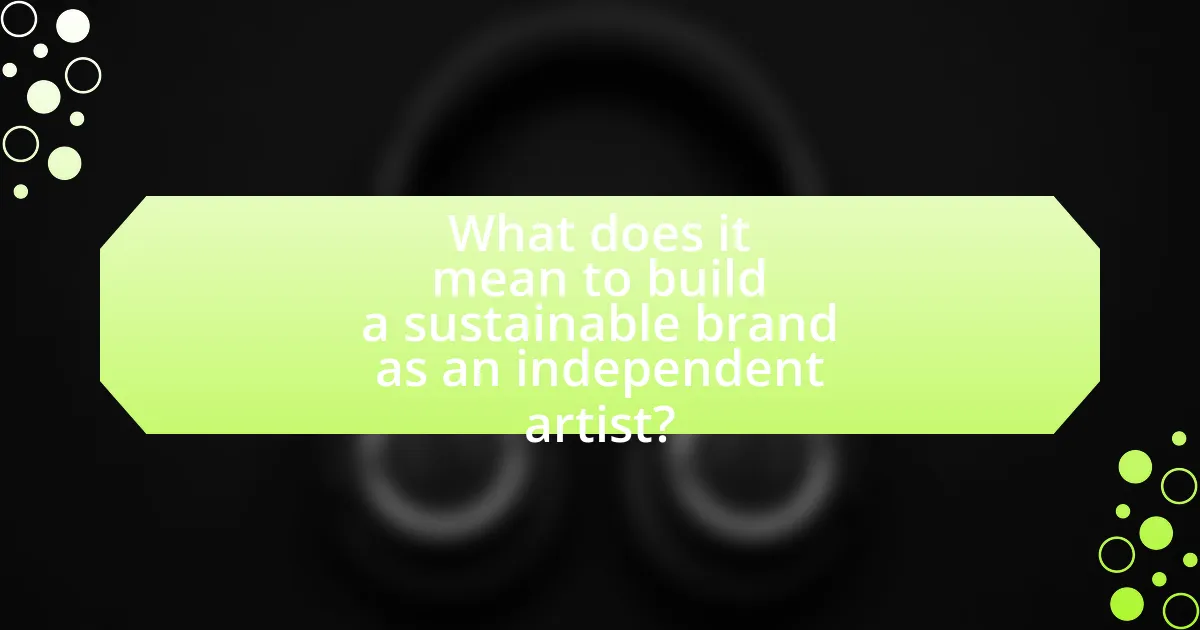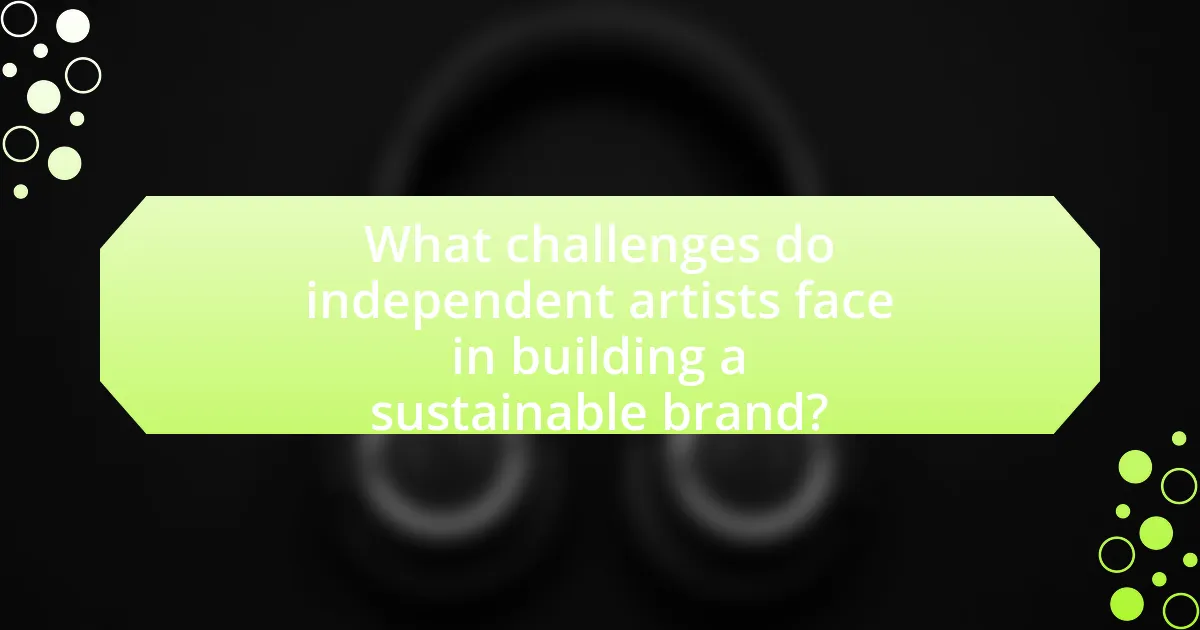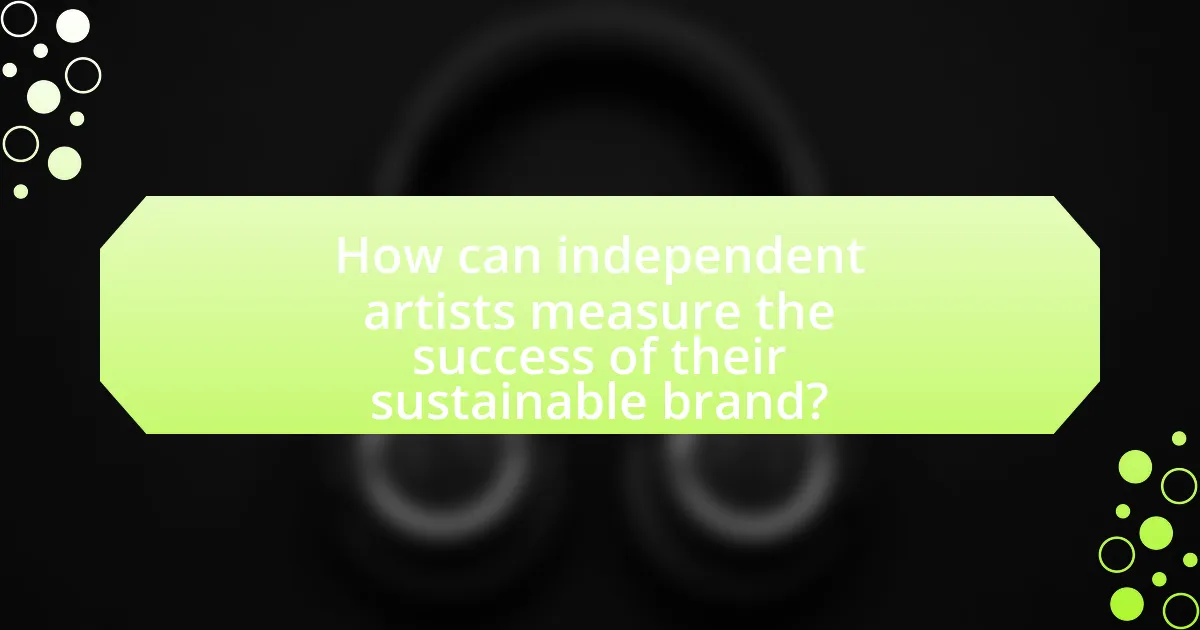Building a sustainable brand as an independent artist involves creating a recognizable identity that emphasizes long-term viability, ethical practices, and community engagement. This article explores the importance of sustainability for independent artists, detailing how it enhances reputation, fosters customer loyalty, and offers long-term benefits. Key elements of a sustainable brand include environmental responsibility, social equity, and economic viability, while audience engagement plays a crucial role in promoting sustainable practices. The article also addresses challenges faced by independent artists, misconceptions about sustainability, and practical strategies for defining brand identity and measuring success.

What does it mean to build a sustainable brand as an independent artist?
Building a sustainable brand as an independent artist means creating a recognizable identity that prioritizes long-term viability, ethical practices, and community engagement. This involves consistently producing quality work, establishing a loyal fan base, and utilizing sustainable practices in production and distribution. For instance, independent artists often leverage digital platforms to reach audiences directly, reducing reliance on traditional music industry structures that may not support sustainability. Additionally, artists can adopt eco-friendly materials for merchandise and promote social causes, enhancing their brand’s appeal and relevance. This approach not only fosters a deeper connection with fans but also contributes to a more responsible and resilient artistic ecosystem.
Why is sustainability important for independent artists?
Sustainability is important for independent artists because it enables them to create a lasting impact while minimizing environmental harm. By adopting sustainable practices, independent artists can reduce waste, utilize eco-friendly materials, and promote social responsibility, which resonates with increasingly conscious consumers. For instance, a survey by Nielsen found that 73% of millennials are willing to pay more for sustainable products, indicating a market preference that artists can leverage. Additionally, sustainable branding can enhance an artist’s reputation, attract a loyal audience, and differentiate them in a competitive industry.
How does sustainability impact an artist’s reputation?
Sustainability significantly enhances an artist’s reputation by aligning their work with socially responsible values. Artists who adopt sustainable practices demonstrate a commitment to environmental stewardship, which resonates with increasingly eco-conscious audiences. For instance, a survey by Nielsen found that 73% of millennials are willing to pay more for sustainable products, indicating that artists who prioritize sustainability can attract a larger, more loyal fan base. Additionally, collaborations with eco-friendly brands can elevate an artist’s visibility and credibility, further solidifying their reputation in the industry.
What are the long-term benefits of a sustainable brand?
A sustainable brand offers long-term benefits such as enhanced customer loyalty, increased market share, and improved financial performance. By prioritizing environmental and social responsibility, sustainable brands attract consumers who value ethical practices, leading to a loyal customer base. Research indicates that 66% of global consumers are willing to pay more for sustainable brands, demonstrating a significant market opportunity. Additionally, sustainable practices often lead to cost savings through efficiency improvements and waste reduction, contributing to better financial outcomes over time. Brands that embrace sustainability also benefit from positive public perception, which can enhance their reputation and attract partnerships, further solidifying their market position.
What are the key elements of a sustainable brand?
The key elements of a sustainable brand include environmental responsibility, social equity, and economic viability. Environmental responsibility involves minimizing ecological impact through sustainable sourcing, production processes, and waste management. Social equity focuses on fair labor practices, community engagement, and transparency in operations. Economic viability ensures that the brand can maintain profitability while adhering to sustainable practices. These elements are supported by research indicating that consumers increasingly prefer brands that demonstrate commitment to sustainability, with a 2021 Nielsen report showing that 73% of global consumers are willing to change their consumption habits to reduce environmental impact.
How do values and mission shape a sustainable brand?
Values and mission shape a sustainable brand by providing a clear framework that guides decision-making and fosters consumer trust. A brand that articulates its values, such as environmental responsibility or social equity, aligns its practices with these principles, which can enhance brand loyalty and attract like-minded customers. For instance, a study by Cone Communications found that 87% of consumers are more likely to purchase a product from a company that advocates for social or environmental issues. This alignment between values and mission not only differentiates the brand in a competitive market but also creates a sense of community among consumers who share similar beliefs, ultimately contributing to the brand’s long-term sustainability.
What role does audience engagement play in sustainability?
Audience engagement is crucial for sustainability as it fosters a community that supports and advocates for sustainable practices. Engaged audiences are more likely to participate in initiatives, share information, and promote sustainable behaviors, which can lead to increased awareness and action towards environmental issues. For instance, a study by the Harvard Business Review found that companies with high customer engagement levels are more successful in implementing sustainable practices, as engaged customers often become brand advocates, driving further engagement and support. This cycle of engagement not only enhances brand loyalty but also contributes to broader sustainability goals by mobilizing collective action.
How can independent artists define their brand identity?
Independent artists can define their brand identity by clearly articulating their unique artistic vision, values, and target audience. This involves identifying what sets them apart from others in the industry, such as their style, message, and the emotions they wish to evoke through their work. For instance, a study by the University of Southern California found that artists who effectively communicate their personal narrative and connect with their audience on an emotional level are more likely to build a loyal fan base. By consistently expressing these elements across various platforms, including social media, websites, and live performances, independent artists can create a cohesive brand identity that resonates with their audience and enhances their marketability.
What steps should artists take to identify their unique voice?
Artists should engage in self-reflection, experimentation, and feedback to identify their unique voice. Self-reflection involves analyzing personal experiences, influences, and values that shape their artistic perspective. Experimentation allows artists to explore various styles, mediums, and techniques, helping them discover what resonates most with their creativity. Seeking feedback from peers and audiences provides valuable insights into how their work is perceived, guiding them toward a more authentic expression. This process is supported by studies indicating that artists who actively reflect and seek external input are more likely to develop a distinctive artistic identity.
How can artists align their identity with sustainable practices?
Artists can align their identity with sustainable practices by integrating eco-friendly materials and methods into their creative processes. This approach not only reflects their commitment to environmental responsibility but also resonates with a growing audience that values sustainability. For instance, artists can use recycled or upcycled materials, which reduces waste and promotes a circular economy. Additionally, adopting digital platforms for showcasing art minimizes the carbon footprint associated with physical exhibitions. Research indicates that 73% of consumers are willing to pay more for sustainable products, highlighting the market potential for artists who embrace these practices. By aligning their artistic identity with sustainability, artists can enhance their brand appeal while contributing positively to the environment.
What strategies can artists use to promote their sustainable brand?
Artists can promote their sustainable brand by leveraging social media platforms to showcase eco-friendly practices and products. By consistently sharing content that highlights their commitment to sustainability, such as using recycled materials or supporting ethical production methods, artists can engage their audience and build a loyal following. Research indicates that 66% of consumers are willing to pay more for sustainable brands, demonstrating a market demand for eco-conscious products. Additionally, collaborating with other sustainable brands or participating in eco-focused events can enhance visibility and credibility within the sustainability community.
How can social media be leveraged for brand promotion?
Social media can be leveraged for brand promotion by creating engaging content that resonates with the target audience. Platforms like Instagram, Facebook, and Twitter allow independent artists to showcase their work, connect with fans, and build a community. For instance, a study by Hootsuite found that 73% of marketers believe that their efforts through social media marketing have been “somewhat effective” or “very effective” for their business. By utilizing targeted advertising, artists can reach specific demographics, enhancing visibility and engagement. Additionally, consistent interaction with followers fosters loyalty and encourages word-of-mouth promotion, which is crucial for brand growth.
What are effective ways to collaborate with other artists or brands?
Effective ways to collaborate with other artists or brands include establishing clear communication, aligning on shared goals, and leveraging each other’s audiences. Clear communication ensures that all parties understand their roles and expectations, which is crucial for a successful partnership. Aligning on shared goals helps to create a unified vision, making the collaboration more impactful. Leveraging each other’s audiences can expand reach and visibility, as seen in successful collaborations like the partnership between Nike and various artists, which not only enhanced brand image but also increased sales. These strategies are essential for building a sustainable brand as an independent artist.

What challenges do independent artists face in building a sustainable brand?
Independent artists face several challenges in building a sustainable brand, including limited financial resources, lack of industry connections, and difficulties in marketing their work effectively. Financial constraints often hinder artists from investing in quality production, promotion, and distribution, which are essential for brand visibility. Additionally, without established networks, independent artists struggle to gain access to opportunities such as collaborations, exhibitions, and performances that can enhance their brand recognition. Furthermore, the digital landscape is saturated, making it challenging for artists to stand out and reach their target audience, as they must navigate social media algorithms and competition from both independent and mainstream artists. These factors collectively impede the ability of independent artists to create and maintain a sustainable brand in a competitive market.
How can financial constraints affect sustainability efforts?
Financial constraints can significantly hinder sustainability efforts by limiting the resources available for eco-friendly practices. Independent artists often face budget restrictions that prevent investment in sustainable materials, renewable energy sources, or environmentally responsible production methods. For instance, a study by the Ellen MacArthur Foundation highlights that companies with limited financial resources are less likely to adopt circular economy practices, which are essential for sustainability. Additionally, financial limitations can lead to prioritizing short-term gains over long-term sustainable strategies, ultimately compromising environmental goals.
What are some cost-effective strategies for sustainable branding?
Cost-effective strategies for sustainable branding include leveraging social media for organic reach, utilizing eco-friendly materials, and engaging in community collaborations. Social media platforms allow independent artists to connect with audiences without significant financial investment, enabling them to share their values and sustainable practices effectively. Using eco-friendly materials in products or packaging not only reduces environmental impact but also appeals to conscious consumers, enhancing brand loyalty. Collaborating with local businesses or artists fosters community support and can lead to shared marketing efforts, amplifying visibility at a lower cost. These strategies are validated by the growing trend of consumers prioritizing sustainability, with 66% of global consumers willing to pay more for sustainable brands, according to Nielsen’s Global Corporate Sustainability Report.
How can artists overcome resource limitations?
Artists can overcome resource limitations by leveraging digital platforms and community support. Utilizing social media and online marketplaces allows artists to showcase their work, reach wider audiences, and sell directly to consumers without the need for traditional galleries. For instance, platforms like Etsy and Instagram have enabled countless independent artists to generate income and build a following with minimal upfront costs. Additionally, artists can collaborate with other creatives to share resources, skills, and networks, thereby reducing individual burdens and enhancing collective visibility. This collaborative approach has been shown to foster innovation and resource sharing, as evidenced by numerous successful artist collectives that thrive on mutual support.
What misconceptions exist about sustainability in the arts?
One misconception about sustainability in the arts is that it solely involves using eco-friendly materials. While material choices are important, sustainability encompasses broader practices, including ethical labor, community engagement, and long-term economic viability. For instance, a study by the Arts Council England highlights that sustainable practices in the arts also involve creating inclusive spaces and supporting local economies, not just focusing on environmental impact. This misconception can lead to a narrow understanding of what it means to be sustainable in artistic practices.
How can artists educate their audience about sustainability?
Artists can educate their audience about sustainability by integrating eco-friendly themes into their work and utilizing their platforms to raise awareness. For instance, artists can create pieces that highlight environmental issues, such as climate change or pollution, prompting discussions among viewers. Additionally, they can host workshops or events focused on sustainable practices, sharing knowledge about materials and methods that minimize environmental impact. Research indicates that art can effectively influence public perception and behavior regarding sustainability, as seen in campaigns that use visual storytelling to convey urgent environmental messages.
What are common myths that hinder sustainable practices?
Common myths that hinder sustainable practices include the belief that sustainable options are always more expensive, that individual actions have little impact, and that sustainability is only relevant for large corporations. The misconception that sustainable products cost significantly more than conventional ones is often disproven by studies showing that the price gap is narrowing as demand increases. Additionally, research indicates that collective individual actions can lead to substantial environmental benefits, as seen in initiatives like community recycling programs. Lastly, the idea that sustainability is solely a corporate responsibility overlooks the critical role that independent artists and small businesses play in promoting eco-friendly practices, as they can influence consumer behavior and drive change within their communities.

How can independent artists measure the success of their sustainable brand?
Independent artists can measure the success of their sustainable brand through key performance indicators (KPIs) such as sales growth, customer engagement, and brand awareness. Sales growth reflects the financial viability of the brand, indicating how well sustainable products resonate with consumers. Customer engagement can be assessed through social media interactions, website traffic, and feedback, showcasing the audience’s connection to the brand’s values. Brand awareness can be measured through surveys and market research, which provide insights into how well the brand is recognized and perceived in the context of sustainability. These metrics collectively offer a comprehensive view of the brand’s impact and effectiveness in promoting sustainability.
What metrics should artists track to evaluate their brand’s impact?
Artists should track engagement metrics, audience growth, and sales performance to evaluate their brand’s impact. Engagement metrics include likes, shares, comments, and overall interaction rates on social media platforms, which indicate how well the audience connects with the artist’s content. Audience growth can be measured through follower counts and demographic insights, providing information on the reach and appeal of the artist’s brand. Sales performance, including merchandise sales, streaming numbers, and ticket sales, directly reflects the financial success and market demand for the artist’s work. These metrics collectively offer a comprehensive view of an artist’s brand effectiveness and market presence.
How can feedback from the audience inform brand adjustments?
Feedback from the audience can inform brand adjustments by providing insights into consumer preferences and perceptions. This information allows brands to identify strengths and weaknesses in their offerings, enabling targeted improvements. For instance, a survey conducted by Nielsen in 2020 revealed that 66% of consumers are willing to pay more for sustainable brands, indicating that audience feedback can highlight the importance of sustainability in brand positioning. By analyzing this feedback, independent artists can refine their branding strategies to better align with audience expectations, ultimately enhancing brand loyalty and market relevance.
What tools are available for measuring sustainability efforts?
Tools available for measuring sustainability efforts include carbon footprint calculators, sustainability reporting frameworks, and life cycle assessment software. Carbon footprint calculators, such as the Greenhouse Gas Protocol, allow organizations to quantify their greenhouse gas emissions, providing a clear metric for sustainability performance. Sustainability reporting frameworks like the Global Reporting Initiative (GRI) offer standardized guidelines for reporting on various sustainability indicators, enabling organizations to assess and communicate their sustainability impacts effectively. Life cycle assessment software, such as SimaPro, evaluates the environmental impacts of products throughout their life cycle, from raw material extraction to disposal, thus providing comprehensive insights into sustainability efforts. These tools are widely recognized and utilized in various industries to enhance transparency and accountability in sustainability practices.
What are best practices for maintaining a sustainable brand over time?
To maintain a sustainable brand over time, independent artists should prioritize authenticity, consistent engagement with their audience, and adaptability to market trends. Authenticity fosters trust and loyalty, as consumers increasingly seek genuine connections with brands. Consistent engagement, through social media and community events, keeps the audience invested and informed about the artist’s journey and projects. Adaptability is crucial, as the creative landscape and consumer preferences evolve; artists must be willing to innovate and pivot their strategies accordingly. Research indicates that brands demonstrating authenticity and engagement see higher customer retention rates, reinforcing the importance of these practices in sustaining a brand.
How can artists stay updated on sustainability trends?
Artists can stay updated on sustainability trends by actively engaging with industry publications, attending workshops, and participating in online forums focused on sustainable practices. Subscribing to journals like “Sustainable Art” and following organizations such as the Green Arts Initiative provides insights into current trends and innovations. Additionally, attending events like the Sustainable Arts Festival allows artists to network with peers and learn from experts in the field. Engaging with social media platforms that focus on sustainability can also provide real-time updates and discussions on emerging trends.
What role does continuous improvement play in brand sustainability?
Continuous improvement is essential for brand sustainability as it enables brands to adapt, innovate, and enhance their practices over time. By consistently evaluating and refining processes, independent artists can reduce waste, optimize resource use, and respond to consumer demands for ethical and sustainable practices. For instance, a study by the Ellen MacArthur Foundation highlights that companies implementing continuous improvement strategies can achieve significant reductions in environmental impact, thereby strengthening their brand reputation and customer loyalty. This iterative approach not only fosters resilience in a competitive market but also aligns with the growing consumer preference for sustainable brands.
What practical tips can independent artists implement for sustainable branding?
Independent artists can implement several practical tips for sustainable branding, including defining a clear brand identity, engaging consistently with their audience, and leveraging digital platforms effectively. A clear brand identity helps artists communicate their unique style and values, which is essential for differentiation in a crowded market. Consistent engagement with the audience fosters loyalty and builds a community around the artist’s work. Utilizing digital platforms, such as social media and personal websites, allows artists to reach a wider audience and maintain visibility. According to a survey by the Artist Revenue Streams project, 70% of artists reported that social media significantly impacted their ability to connect with fans and promote their work.
